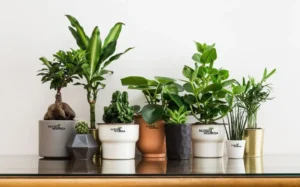Lucky Plants for Home as per Vastu
Incorporating plants into your home not only adds natural beauty but can also bring positive energy and harmony. According to Vastu Shastra, the ancient Indian science of architecture and design. Vastu experts recommend these lucky plants to promote well-being and prosperity in your home.

1) Citrus plants:
Citrus plants are a genus belonging to the Rutaceae family. Some common examples include oranges, lemons, limes, grapefruits, kumquat, tangerines, and other hybrids. These plants are easy to grow houseplants but fruit much easily outdoors in full sun. According to Feng Shui customs in Chinese traditions, the citrus plant can absorb negative energy from people around it and transfer it to its fruits, making them sour. By sucking the lousy energy citrus plants bring positive activity to our households, resulting in good luck.
Care for Citrus plants:-
- These plants love the sun and will appreciate at least 8 hours of sun, for efficient fruiting.
- They want soil that is consistently kept damp but not soggy, as soggy soil can cause root rot. To prevent soggy soil, let the soil dry out in between waterings, but don’t let the soil dry for longer than 2 days.
- Citrus plants also don’t fare well in temperatures colder than -1°C, hence they are not ideal for places that get frosts in the winters.
- These plants are also prone to getting diseases like a citrus canker.
If you’re interested in getting one, check out these links orange plant, rough lemon plant, grapefruit plant, or visit Nursery Nisarga
2) Tulsi plant:
Tulsi or holy basil is a very familiar plant in the family Lamiaceae, which also includes mint, rosemary, sage, and oregano. This plant grows more readily outdoors and loves the sun, with a minimum requirement of at least 5 hours of sun, it too has an affinity for water and asks for water by drooping leaves. Holy basil is a shrub so it stays relatively small and has a very distinctive smell, a characteristic of the Lamiaceae family. The foliage is mid-green with a fuzzy appearance, it also produces small flowers with a colour in the range of purple. According to some Hindu myths and Vastu Shastra, Tulsi was an ardent lover of Krishna who was cursed by Radha and turned into a plant. Homes with Tulsi stay free of death and bad luck and are filled with positivity and optimism.
Care for Tulsi plant:-
- Tulsi loves the shaded sun, so keep these plants in areas that receive direct morning light but are shaded during the afternoon.
- These plants don’t like dry compact soil, so make sure to aerate the soil with a stick
- Holy basil loves moist soil so keep it moist, but avoid overwatering. Water your plant when the leaves start to droop. A common mistake people make with this plant is that they add oil to the plant’s roots, this kills the plant by cutting the supply of water to the roots. Never add oil to any plant.
If you’re interested in getting one, check this tulsi plant or visit nurserynisarga
3.) Jade plant:
This plant is a succulent native to Eastern Cape in South Africa and Mozambique. It has an appearance similar to that of a small tree when completely mature. it appreciates a lot of sun, but it is, however, prone to a lot of moisture, so keep it on the drier side and it’s better to not water it when in doubt. This plant doesn’t like attention, just like other succulents. According to some African myths, Unkulunkulu, the creator of humanity, gifted humans the Jade plants to use as a source of money, as it is very easy to propagate and just a leaf is enough to make a new plant.
Care for Jade plant:-
- Jade plant just like other succulents dislikes constantly moist soil and high humidity. Keep Pachira Aquatica dry for the majority of the time, and when watering, thoroughly water it until water starts to come out from the bottom of the pot.
- You can place this plant in direct sunlight, but it fares much better in shaded sun. Younger plants require shaded light and will crisp up in intense, direct sunlight, but older specimens can handle it and will develop a beautiful shade of red under sun stress.
- Ideally, fertilize it every growing season, from spring to summer.
If you’re interested in getting one, check these links miniature jade plant or variegated jade plant or visit nursery nisarga
4.) Money tree (Pachira Aquatica):
Pachira Aquatica, also known as the Money Tree or Guiana Chestnut. It is a tropical plant native to Central and South America. Its braided trunk and lush green foliage characterize it, making it a popular choice for indoor decoration. This plant loves water and prefers moist soil with high humid air. You should leave it to dry for a while before watering it again. Vastu experts recommends these lucky plants for home as per vastu .
Money tree care:-
- Pachira Aquatica thrives in bright, indirect light but can tolerate moderate shade.
- It prefers consistently moist soil but avoid allowing it to sit in waterlogged conditions, as this can lead to root rot.
- The plant benefits from occasional pruning to maintain its shape and promote healthy growth.
- Protect Pachira Aquatica from drafts and frost because it is sensitive to cold temperatures.
Check out the link money tree to buy it from nursery nisarga.
5.) Money plant (Epipremnum aureae):
The money plant, also known as Pothos is a very common houseplant. Plants in the family Araceae include philodendrons, anthuriums, and alocasias, among others. It is native to the Polynesian islands of French society. The legend of Epipremnum is similar to that of the money tree, because of the ease of its propagation. This plant can be sold to earn money, hence the name money plant. It is said to be a bringer of good luck and positivity by increasing liveliness in closed spaces. This auspicious plant for home according to Vastu .




